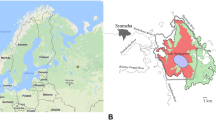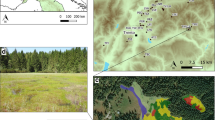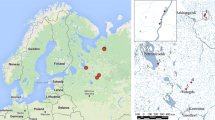Abstract
Higher Diptera (Schizophora) are taxonomically and ecologically diverse, and include bog specialist and bog-associated species known to respond to peatland disturbance. We examined the effects of three factors (habitat size, vegetation cover and surrounding land use measured in concentric circles of 500, 1000, 1500, and 2000 m radii from the sampling location) on Schizophora species richness, diversity, and composition in six temperate eastern Nearctic bogs. A total of 381 species of Schizophora were collected with observed species richness among sites ranging from 96 to 182. Assemblages in apparently similar peatlands were highly variable, but characterized by a few highly dominant species, most of which are not peatland specialists. Bog size had no influence on species richness or diversity. Vegetation cover at the sampling sites and surrounding land use at the largest scales measured (1500 and 2000 m) both influenced species assemblages.




Similar content being viewed by others
References
Bélanger L, Grenier M, Deslandes S (1999) Report on habitat and land use in southern Québec. Environment Canada, Canadian Wildlife Service, Québec City, QC, Canada. http://www.qc.ec.gc.ca/faune/bilan/bilanhabitat.html. Accessed August 2008
Blades DCA, Marshall SA (1994) Terrestrial arthropods of Canadian peatlands: Synopsis of pan trap collections at four southern Ontario peatlands. In: Finnamore AT, Marshall SA (eds) Terrestrial arthropods of peatlands, with particular reference to Canada. Memoirs of the Entomological Society of Canada 169, pp 221–284
Brown BV (1993) A further chemical alternative to critical— point-drying for preparing small (or large) flies. Fly Times 11:10
Calmé S, Desrochers A (2000) Biogeographic aspects of the distribution of bird species breeding in Québec’s peatlands. Journal of Biogeography 27:725–732
Canada E (1991) The federal policy on wetland conservation. Environment Canada, Ottawa
Chao A, Lee S-M (1992) Estimating the number of classes via sample coverage. Journal of the American Statistical Association 87:210–217
Chesson PS, Huntly N (1997) The role of harsh and fluctuating conditions in the dynamics of ecological communities. American Naturalist 150:519–553
Colwell RK (2009) EstimateS: Statistical estimation of species richness and shared species from samples. Version 8.2. Available at: http://purl.oclc.org/estimates. Accessed December 2009
Connell JH (1978) Diversity in tropical rain forests and coral reefs. Science 199:1302–1310
Dahlem GA, Naczi RFC (2006) Flesh flies (Diptera: Sarcophagidae) associated with North American pitcher plants (Sarraceniaceae), with descriptions of three new species. Annals of the Entomological Society of America 99:218–240
Davies KF, Margules CR, Lawrence JF (2000) Which traits of species predict population declines in experimental forest fragments? Ecology 81:1450–1461
R Development Core Team (2009) R: A language and environment for Statistical computing. R Foundation for Statistical Computing, Vienna. Available at: http://www.R-project.org. Accessed August 2009
Didham RF, Ghazoul J, Stork NE, Davis AJ (1996) Insects in fragmented forests: a functional approach. Trends in Ecology and Evolution 11:255–260
ESRI (2006) ArcMap. Version 9.2. Available at: www.esri.com. Accessed July 2008
Finch S, Collier RH (2004) A simple method— based on the carrot fly— for studying the movement of pest insects. Entomologica Experimentalis et Applicata 117:15–25
Findlay CS, Houlahan J (1997) Anthropogenic correlates of species richness in southeastern Ontario wetlands. Conservation Biology 11:1000–1009
Finnamore AT (1994) Hymenoptera of the Wagner Bog Natural Area, a boreal spring fen in central Alberta. In: Finnamore AT, Marshall SA (eds) Terrestrial arthropods of peatlands, with particular reference to Canada. Memoirs of the Entomological Society of Canada 169, pp 181–220
US Forest Service (1997) Northeastern Forest Inventory and Analysis— Statewide Results. US Department of Agriculture, Forest Inventory and Analysis Program, Newton Square. Available at: http://www.fs.fed.us/ne/fia/states/vt/1997.html. Accessed July 2008
Gibbs JP, Stanton EJ (2001) Habitat fragmentation and arthropod community change: Carrion beetles, phoretic mites, and flies. Ecological Applications 11:79–85
Gonzalez A (2000) Community relaxation in fragmented landscapes: the relation between species richness, area and age. Ecology Letters 3:441–448
Gotelli NJ, Colwell RK (2001) Quantifying biodiversity: procedures and pitfalls in the measurement and comparison of species richness. Ecology Letters 4:379–391
Gotelli NJ, Entsminger GL (2005) EcoSim: Null models software for ecology. Version 7.72. Acquired Intelligence Inc. and Kesey-Bear. Available at: http://homepages.together.net/~gentsmin/ecosim.htm. Accessed August 2009
Grégoire Taillefer A (2008) Colonization of restored peatlands by insects: Diptera assemblages in mined and restored bogs in eastern Canada. Dissertation, McGill University
Grégoire Taillefer A, Wheeler TA (2010) Effect of drainage ditches on Brachycera (Diptera) diversity in a southern Quebec peatland. The Canadian Entomologist 142:160–168
Hamer KC, Hill JK, Lace LA, Langan AM (1997) Ecological and biogeographical effects of forest disturbance on tropical butterflies of Sumba: Indonesia. Journal of Biogeography 24:67–75
Harrison S, Bruna E (1999) Habitat fragmentation and large-scale conservation: what do we know for sure? Ecography 22:225–232
Heikkinen RK, Luoto M, Virkkala R, Raino K (2004) Effects of habitat cover, landscape structure and spatial variables on the abundance of birds in an agricultural–forest mosaic. Journal of Applied Ecology 41:824–835
Hendrickx F, Maelfait J-P, Van Wingerden W, Schweiger O, Speelmans M, Aviron S, Augenstein I, Billeter R, Bailey D, Bukacek R, Burel F, Diekötter T, Dirksen J, Herzog F, Liira J, Roubalova M, Vandomme V, Bugter R (2007) How landscape structure, land-use intensity and habitat diversity affect components of total arthropod diversity in agricultural landscapes. Journal of Applied Ecology 44:340–351
Huston MA (1994) Biological diversity: the coexistence of species on changing landscapes. Cambridge University Press, Cambridge
Johnson CG (1969) Migration and dispersal of insects by flight. The Chaucer Press, Suffolk
Keiper JB, Walton WE, Foote BA (2002) Biology and ecology of higher Diptera from freshwater wetlands. Annual Review of Entomology 47:207–232
Keitt TH, Urban DL, Milne BT (1997). Detecting critical scales in fragmented landscapes. Conservation Ecology [online] 1(1):4. Available at: http://www.consecol.org/vol1/iss1/art4/. Accessed July 2008
Kishbaugh MA, Yocom DH (2000) The impact of habitat fragmentation on arthropod diversity: an experimental study. American Biology Teacher 62:414–420
Krauss J, Steffan-Dewenter I, Tscharntke T (2003) How does landscape context contribute to effects of habitat fragmentation on diversity and population density of butterflies? Journal of Biogeography 30:889–900
Lavoie C (2001) Les arthropodes. In: Payette S, Rochefort L (eds) Ecologie des tourbières du Québec-Labrador: Une perspective nord-américaine. Les Presses de l’Université Laval, Québec City, pp 175–180
Lövei GL, Magura T, Tóthmérész B, Ködöböcz V (2006) The influence of matrix and edges on species richness patterns of ground beetles (Coleoptera: Carabidae) in habitat islands. Global Ecology and Biogeography 15:283–289
MacArthur R, Wilson EO (1967) The theory of island biogeography. Princeton University Press, Princeton
Magurran AE (2004) Measuring Biological Diversity. Blackwell Publishing, Malden
Malterer TJ (1996) Peat resources of the United States. In: Lappalainen E (ed) Global Peat Resources. International Peat Society, Jyska, pp 253–260
Marshall SA (1994) Peatland Sphaeroceridae (Diptera) of Canada. In: Finnamore AT, Marshall SA (eds) Terrestrial arthropods of peatlands, with particular reference to Canada. Memoirs of the Entomological Society of Canada 169, pp 173–179
Mazerolle DF, Hobson KA (2002) Consequences of forest fragmentation on territory quality of male Ovenbirds breeding in western boreal forests. Canadian Journal of Zoology 80:1841–1848
McAlpine JF, Peterson BV, Shewell GE, Teskey HJ, Vockeroth JR, Wood DM (1981) Introduction. In: McAlpine JF et al (eds) Manual of Nearctic Diptera Vol. 1, Agriculture Canada Monograph 27, Ottawa, pp 1–7
McAlpine JF, Peterson BV, Shewell GE, Teskey HJ, Vockeroth JR, Wood DM (eds) (1987) Manual of Nearctic Diptera Vol. 2, Agriculture Canada Monograph 28, Ottawa
McCullagh P, Nelder JA (1989) Generalized Linear Models. Chapman & Hall, London
McCune B, Mefford MJ (2005) PC-ORD. Multivariate Analysis of Ecological Data. Version 4.36. MjM Software, Gleneden Beach
Meats A, Smallridge CJ (2007) Short- and long-range dispersal of medfly, Ceratitis capitata (Dipt. Tephritidae), and its invasive potential. Journal of Applied Entomology 131:518–523
Miller RM (1977) Taxonomy and biology of the Nearctic species of Homoneura (Diptera: Lauxaniidae). I. Subgenera Mallochomyza and Tarsohomoneura. Iowa State Journal of Research 52:147–176
Ministère de l’environnement (2000) Les réserves écologiques: des habitats protégés au naturel. Ministère de l’environnement, Québec City
Moertelmaier T (1996) Struktur und Dynamik von Syrphidenge-meinschaften (Insecta/Diptera/Syrphidae) ausgewählter walddominierter Habitat- und Landutzungsmosaike im Nationalpark Berchtesgaden. Dissertation, University of Salzburg
Nupp TE, Swihart RK (2000) Landscape-level correlates of small-mammal assemblages in forest fragments of farmland. Journal of Mammalogy 81:512–526
O’Neill KP (2000) Role of bryophyte-dominated ecosystems in the global carbon budget. In: Shaw AJ, Goffinet B (eds) Bryophyte Biology. Cambridge University Press, Cambridge, pp 344–368
Økland B, Bakke A, Hågvar S, Kvamme T (1996) What factors influence the diversity of saproxylic beetles? A multiscaled study from a spruce forest in southern Norway. Biodiversity and Conservation 5:75–100
Platt WJ, Connell JH (2003) Natural disturbances and directional replacement of species. Ecological Monographs 73:507–522
Poulin M, Pellerin S (2001) La conservation des tourbières: le contexte international, canadien et québécois. In: Payette S, Rochefort L (eds) Ecologie des tourbières du Québec-Labrador: Une perspective nord-américaine. Les Presses de l’Université Laval, Québec City, pp 505–518
Ricketts TH, Daily GC, Ehrlich PR, Fay JP (2001) Country-side biogeography of moths in a fragmented landscape: biodiversity in native and agricultural habitats. Conservation Biology 15:378–388
Rosenberg DM, Danks HV (1987) Aquatic insects of peatlands and marshes in Canada: Introduction. In: Rosenberg DM, Danks HV (eds) Aquatic Insects of peatlands and marshes in Canada. Memoirs of the Entomological Society of Canada 140, pp 1–4
Saunders DA, Hobbs RJ, Margules CR (1991) Biological consequences of ecosystem fragmentation: a review. Conservation Biology 5:18–32
Schmidt MH, Tscharntke T (2005) The role of perennial habitats for central European farmland spiders. Agriculture, Ecosystems and Environment 105:235–242
Schweiger O, Maelfait J-P, Van Wingerden W, Hendrickx F, Billeter R, Speelmans M, Augenstein I, Aukema B, Aviron S, Bailey D, Bukacek R, Burel F, Diekötter T, Dirksen J, Frenzel M, Herzog F, Liira J, Roubalova M, Bugter R (2005) Quantifying the impact of environmental factors on arthropod communities in agricultural landscapes across organisational levels and spatial scales. Journal of Applied Ecology 42:1129–1139
Spitzer K, Danks HV (2006) Insect biodiversity of boreal peat bogs. Annual Review of Entomology 51:137–161
Spitzer K, Novotny V, Tonner M, Lepš J (1993) Habitat preferences, distribution and seasonality of the butterflies (Lepidoptera, Papilionoidea) in a montane tropical rainforest, Vietnam. Journal of Biogeography 20:109–121
Spitzer K, Jarog J, Havelka J, Lepš J (1997) Effect of small-scale disturbance on butterfly communities of an Indochinese montane rainforest. Biological Conservation 80:9–15
Spitzer K, Bezdĕk A, Jaroš J (1999) Ecological succession of a relict Central European peat bog and variability of its insect biodiversity. Journal of Insect Conservation 3:97–106
Steffan-Dewenter I (2003) Importance of habitat area and landscape context for species richness of bees and wasps in fragmented orchard meadows. Conservation Biology 17:1036–1044
Steffan-Dewenter I, Munzenberg U, Burger C, Thies C, Tscharntke T (2002) Scale-dependant effects of landscape context on three pollinator guilds. Ecology 83:1421–1432
Stein W (1986) Dispersal of Insects of Public Health Importance. In: Danthanarayana W (ed) Insect Flight: Dispersal and Migration. Springer, Berlin, pp 242–252
Stockwell SS (1994) Habitat selection and community organization of birds in eight peatlands of Maine. Dissertation, University of Maine
Tarnocai C, Kettles IM, Lacelle B (2005) Peatlands of Canada. Agriculture and Agri-Food Canada, Ottawa
Tiner RW (1999) Wetland Indicators. Lewis Publishers, Boca Raton
Townsend CR, Scarsbrook MR, Doledec S (1997) The intermediate disturbance hypothesis, refugia, and biodiversity in streams. Limnology and Oceanography 42:938–949
Vermont Wetlands Office (2003) Wetlands Fact Sheet: Vermont wetland rules summary. Department of Environmental Conservation, Water Quality Division, Wetland Office. Available at: http://www.vtwaterquality.org/wetlands/docs/wl_factsheet4.pdf. Accessed July 2008
Ward JV, Stanford JA (1983) The intermediate disturbance hypothesis: an explanation for biotic diversity patterns in lotic ecosystems. In: Fontaine TD III, Bartell SM (eds) Dynamics of Lotic Ecosystems. Ann Arbor Science, Ann Arbor, pp 347–356
Whiles MR, Goldowitz BS (2001) Hydrologic influences on insect emergence production from Central Platte river wetlands. Ecological Applications 11:1829–1842
US Fish and Wildlife Service (2008) North American Wetlands Conservation Act: Factsheet. US Department of Interior, Arlington. Available at: http://www.fws.gov/birdhabitat/grants/nawca/files/nawccbrocwithedits.pdf. Accessed July 2008
Acknowledgments
We thank Gilbert and Enid Elliot (Ogden, QC), Parc national de Frontenac, Lake Carmi State Park; Andrée Giroux (MDDEP), Ian Worley and Bill Gill (University of Vermont) and Eric Sorenson (Vermont Department of Fish and Wildlife) for information and access to bogs. Gabrielle Gagnon, Peter Kraska and James Kuchta assisted with field work. James O’Hara and Monty Wood (Canadian National Collection of Insects) identified Tachinidae and Marjolaine Giroux (McGill University) identified Sarcophagidae. Rosa Orlandini and Joanna Hobbins (Walter Hitschfeld Geographic Information Centre) advised on GIS analysis. Chris Buddle (McGill University) and Robert van Hulst (Bishop’s University) provided statistical advice and assistance. Financial support was provided by Natural Sciences and Engineering Research Council of Canada (NSERC) grants to JS and TAW, a Fonds québecois de la recherche sur la nature et les technologies (FQRNT) grant to JS and an NSERC Postgraduate Scholarship to AM.
Author information
Authors and Affiliations
Corresponding author
Electronic Supplementary Materials
Below is the link to the electronic supplementary material.
Online Resource
(PDF 992 kb)
Rights and permissions
About this article
Cite this article
Savage, J., Wheeler, T.A., Moores, A.M.A. et al. Effects of Habitat Size, Vegetation Cover, and Surrounding Land Use on Diptera Diversity in Temperate Nearctic Bogs. Wetlands 31, 125–134 (2011). https://doi.org/10.1007/s13157-010-0133-8
Received:
Accepted:
Published:
Issue Date:
DOI: https://doi.org/10.1007/s13157-010-0133-8




